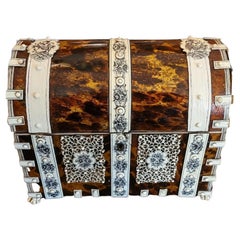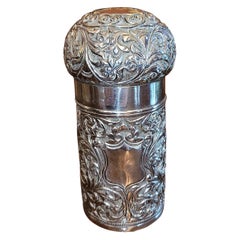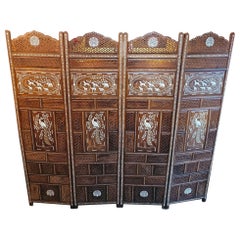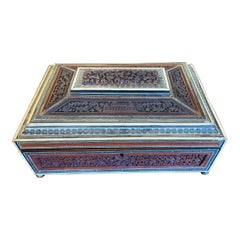Want more images or videos?
Request additional images or videos from the seller
1 of 11
Anglo-Indian Bone Inlaid Nest of Tables
$1,250List Price
About the Item
- Dimensions:Height: 18 in (45.72 cm)Width: 17.75 in (45.09 cm)Depth: 13.5 in (34.29 cm)
- Style:Anglo Raj (Of the Period)
- Materials and Techniques:
- Place of Origin:
- Period:
- Date of Manufacture:1890-1900
- Condition:Wear consistent with age and use. Near Mint.
- Seller Location:Dallas, TX
- Reference Number:1stDibs: LU3978113433102
About the Seller
4.9
Gold Seller
Premium sellers maintaining a 4.3+ rating and 24-hour response times
Established in 2015
1stDibs seller since 2018
397 sales on 1stDibs
Authenticity Guarantee
In the unlikely event there’s an issue with an item’s authenticity, contact us within 1 year for a full refund. DetailsMoney-Back Guarantee
If your item is not as described, is damaged in transit, or does not arrive, contact us within 7 days for a full refund. Details24-Hour Cancellation
You have a 24-hour grace period in which to reconsider your purchase, with no questions asked.Vetted Professional Sellers
Our world-class sellers must adhere to strict standards for service and quality, maintaining the integrity of our listings.Price-Match Guarantee
If you find that a seller listed the same item for a lower price elsewhere, we’ll match it.Trusted Global Delivery
Our best-in-class carrier network provides specialized shipping options worldwide, including custom delivery.You May Also Like
Antique French Inlaid Nest of Tables
Located in London, GB
A stunning antique French inlaid nest of tables. This was made in France, it dates from around the 1930’s.
The quality is fantastic, this is beautifully made with gorgeous inlays on...
Category
Vintage 1930s French Louis XV Nesting Tables and Stacking Tables
Materials
Brass, Ormolu
A Fabulous Edwardian Nest of Four Inlaid Tables
Located in Dublin, IE
A fabulous Edwardian nest of four richly patinated mahogany tables, of exceptional quality, finely carved and beautifully inlaid throughout. The well figured, moulded, galleried and...
Category
Early 20th Century English Edwardian Nesting Tables and Stacking Tables
Materials
Mahogany
A Stunning Edwardian Inlaid Nest of Four Tables
Located in Dublin, IE
A stunning Edwardian nest of four richly patinated mahogany and Birds Eye maple tables of exceptional quality, finely carved and beautifully inla...
Category
Early 20th Century English Edwardian Nesting Tables and Stacking Tables
Materials
Birdseye Maple, Mahogany
Set of 5 Antique Anglo-Indian Wood & Brass Accented Graduated Stacking Tables
Located in Hamilton, Ontario
This set of five graduated stacking tables show no maker's marks, but are presumed to have originated from India and dating to approximately 1920 and done in an Anglo-Indian style. T...
Category
Early 20th Century Indian Anglo-Indian Nesting Tables and Stacking Tables
Materials
Brass
$1,295 / set
H 25.5 in Dm 23 in
Antique French Inlaid Walnut Nest of Three Tables
Located in London, GB
A beautiful antique nest of tables in walnut, this was made in France, it dates from around the 1900-1920 period.
The quality is superb, this is very well made and it is an extremel...
Category
Antique Early 1900s French Louis XV Nesting Tables and Stacking Tables
Materials
Walnut
Lovely Vintage French Inlaid Parquetry Nest of Tables
Located in Pulborough, GB
We are delighted to offer for sale this Lovely Vintage French Parquetry Nest Of Tables.
A lovely and elegant French Louis XV style parquetry nest of tables. This has been lightly ...
Category
20th Century French Louis XV Nesting Tables and Stacking Tables
Materials
Wood
Antique Edwardian quality mahogany inlaid nest of three tables
Located in Ipswich, GB
Antique Edwardian quality mahogany inlaid nest of three tables having quality mahogany inlaid oval tables supported by turned columns standing on shaped feet united by a mahogany str...
Category
Early 20th Century Edwardian Nesting Tables and Stacking Tables
Materials
Mahogany
$1,268
H 27.37 in W 25.01 in D 15.95 in
Nest of three antique Edwardian quality mahogany inlaid tables
Located in Ipswich, GB
Nest of three antique Edwardian quality mahogany inlaid tables having a quality mahogany rectangular shaped top with inlaid satinwood, standing on elegant square tapering legs united...
Category
Early 20th Century Edwardian Nesting Tables and Stacking Tables
Materials
Mahogany
$1,107 / set
H 27.56 in W 18.12 in D 11.82 in
Nest of 4 Tables, in Carved Teak
Located in Godshill, Isle of Wight
Nest of 4 Tables, in Carved Teak
This is a very attractive set of tables, each one slightly different with a beautiful pierced border and a ribbon waved edg...
Category
Mid-20th Century Anglo-Indian Nesting Tables and Stacking Tables
Materials
Teak
Superb Quality Antique Edwardian Mahogany Inlaid Quartetto Nest of Tables
Located in Suffolk, GB
Superb quality antique Edwardian mahogany inlaid quartetto nest of tables
consisting of four superb quality mahogany inlaid tables supported by fine quality turned columns standing o...
Category
Early 20th Century English Edwardian Nesting Tables and Stacking Tables
Materials
Other
$1,939 / set
H 25.79 in W 20.08 in D 12.21 in
More From This Seller
View All19C Anglo Indian Vizagapatam Bone and Shell Domed Stationery Box
Located in Dallas, TX
PRESENTING A LOVELY 19C Anglo Indian Vizagapatam Bone and Shell Domed Stationery Box – ‘Alice’s Box’.
Made in Vizagapatam, India, circa 1860-80.
We call this one: “Alice’s Box”! It has lived ‘a hard, well used and traveled life’, as is evident from the number of losses and repairs, as is obvious from the photos, especially to the faux ivory panels and bands to the top. The bonus to the loss of the frieze panels to the dome has a ‘bonus’, however, as their loss has revealed the most GORGEOUS faux blonde tortoiseshell underneath!
The box is dome/casket shaped.
The top has 3 bands, with the center one being the original. The 2 side bands are later ivorine.
The faux ivory and hand-painted medallions on the domed lid, have been saved and they depict Hindu Gods, Vishnu and Shiva.
The front and side panels are still in pretty good shape and are decorated with lac ink (indelible ink made from crushed beetles) depicting lovely floral designs.
The domed lid open to reveal a series of open compartments for envelopes, writing paper etc. and one lidded panel for stamps.
Inside the box are 2 paper labels: one probably being the original item ticket and the other with:
” Alice’s address is 272 Ashworth Ave, Toronto 4, Ontario”.
Probably, the original owner? Hence, we call it ‘Alice’s Box’.
What a journey/life this box has had!
Made in India, made its way to Canada, back to Ireland and then to Texas!
This is why, WE LOVE ANTIQUES...
Category
Antique 19th Century Indian Anglo-Indian Decorative Boxes
Materials
Bone, Shell, Sandalwood
19C Anglo Indian Silver Perfume Bottle Case
Located in Dallas, TX
19C Anglo Indian solid silver perfume bottle case.
Lovely 19th century Anglo-Indian solid silver perfume bottle case with profuse repousse work.
Not hallmarked because it was m...
Category
Antique Late 19th Century Indian Anglo Raj Sterling Silver
Materials
Sterling Silver
20C Anglo Indian Style Double Sided Profusely Inlaid 4 Panel Screen
Located in Dallas, TX
PRESENTING AN EXCEPTIONAL 20C Anglo Indian Style Double Sided Profusely Inlaid 4 Panel Screen or Room Divider.
Made in Hoshiarpur, India, circa 1960-80.
Made of ‘teak’ wood in the ...
Category
20th Century Indian Anglo-Indian Screens and Room Dividers
Materials
Ebony, Plastic, Teak
19C Anglo Indian Highly Carved Teak Sadeli Mosaic Inlaid Sewing Box
Located in Dallas, TX
PRESENTING A LOVELY 19C Anglo Indian Highly Carved Sadeli Mosaic Inlaid Sewing Box.
Made in Bombay, India, circa 1880.
The box is made of sandalwood with highly carved raised teak wood panels on all sides, depicting temple scenes, animals and foliage.
The box is in a sarcophagus form.
It is edged in bone (and we can tell it is bone and not ivory, from the color and evidence of capillaries, which are not found in ivory), and banded with Bombay Sadeli mosaic and ebony veneer.
The lid opens to reveal a removable tray with various open compartments and lidded compartments. 5 lidded compartments, 1 unlidded compartment and 8 holders for thimbles, etc
The tray lifts to reveal a blue velvet (original) lined section, for storing jewelry etc, with sections for collars etc.
The inside of the lid has a removable mirror (the mirror is missing on this one but can easily be replaced). Behind the mirror is the original green velvet lining.
It has its original brass carry handles on the sides and sits on 4 silvered button feet (of recent origin).
Some repairs to the exterior and condition issues (priced accordingly), but still a LOVELY COLLECTIBLE box!
These boxes were made by superb Indian craftsmen, specifically for sale to the ruling British elite. These types of boxes, carved padouk and sandalwood, (whilst beautiful and superbly crafted) were of a lesser quality, than the more profusely and intricately mosaic inlay, tortoiseshell and ivory boxes, made for the British ‘Upper Classes’ in the areas of Bombay and Vizagapatam. These type of boxes were much more affordable back in 1880 (and indeed today) and would probably have been bought by mid-level diplomats, civil servants or visitors.
Sewing boxes (in general), were in EVERY Victorian home in Britain in the 19th century and like other boxes etc were ‘status symbols’ of your place in society! The more ornate the box, the more ‘Upper Class’ you were!
SADELI MOSAIC: “Anglo Indian boxes were made in India for the English residents from the early part of the 18th century. They were brought back or sent back to England usually by the people who had commissioned them. From the beginning of the nineteenth century they were imported more commercially, although not in any significant numbers until the middle decades. They were very highly valued, especially the early ones, to the extent that the designs were copied on late 19th and early 20th century tins.
The ancient art of Sadeli Mosaic is said to have been introduced from Shiraz in Persia via Sind to Bombay, a long time before the Anglo Indian boxes were made. It was a technique, which required a high degree of skill and patience. It was executed very lavishly, in that the frequent cuts wasted a great amount of the precious materials used. The workmanship was however more than commensurable to the value of the materials.
Ivory, silver, pewter (or other metals), wood and Horn were cut into faceted rods which were bound together to form geometric patterns. When the glue has set, the rods were sliced in transverse sections. This gave the maker a number of angled circular pieces in the original pattern. Several variations of patterns could be achieved by combining the materials in different ways. The ivory was sometimes dyed green to give an extra color.
The mosaic pieces in a combination of patterns, often separated by ivory, ebony, Horn or silver stringing were used to veneer sandalwood boxes. In the early boxes, which date from the turn of the 18th to the 19th century, there are large panels of mosaic covering tops and sides of boxes. It took incredible skill to cover such large areas without any shakes or wavering of the pattern. The corners and joins on these boxes are impeccably matched.
The makers (reputed to be Persian) of Sadeli mosaic made in the first two decades of the 19th century displayed a total understanding of the qualities of the different materials they used. They combined substances, which can expand and contract according to atmospheric conditions with others, which are hard and unyielding. The result was a sharp definition of the lines and patterns, which made up the whole design.
On the early boxes the designs look deceptively simple. The fact is, they emerged from a culture, which had mastered geometry and understood how to generate a pattern from a set number of points. The patterns are so harmoniously combined that their incredible complexity is not immediately apparent.
The earliest Sadeli boxes...
Category
Antique Late 19th Century Indian Anglo-Indian Decorative Boxes
Materials
Bone, Sandalwood, Teak
19th Century Anglo-Indian Spice or Tea Caddy with Silver Mounts
Located in Dallas, TX
PRESENTING A GORGEOUS 19C Anglo Indian Rosewood Caddy with Silver Mounts.
Really nice and unusual, 19th Century Anglo-Indian Spice or Tea Caddy, from cir...
Category
Antique Late 19th Century Indian Anglo Raj Tea Caddies
Materials
Sterling Silver
19C Anglo Indian Vizigapatam Stamp Box
Located in Dallas, TX
Presenting an absolutely gorgeous and very rare 19C Anglo Indian Vizigapatam stamp box.
Made in Colonial India (the Time of the Raj) circa 1860.
Prob...
Category
Antique Mid-19th Century Indian Anglo-Indian Decorative Boxes
Materials
Bone, Shell
Recently Viewed
View AllMore Ways To Browse
Antique Punjab
Inlaid Nesting Tables
Teak Nest Of Tables
Teak Bone Inlay
Indian Bone Inlay Table
Chrome And Glass Nesting Tables
Brass Inlay Nesting Tables
Wood And Glass Nesting Tables
Chrome Glass Stacking Tables
4 Nesting Tables
Midcentury Iron Nesting Tables
Italian Brass And Glass Nesting Tables
Brass And Marble Nesting Table
Gold Nesting Tables
Nest Of 3 Side Tables
Set Of 3 Inlay Nesting Tables
Mirrored Nesting Tables
Nest Tables Glass



